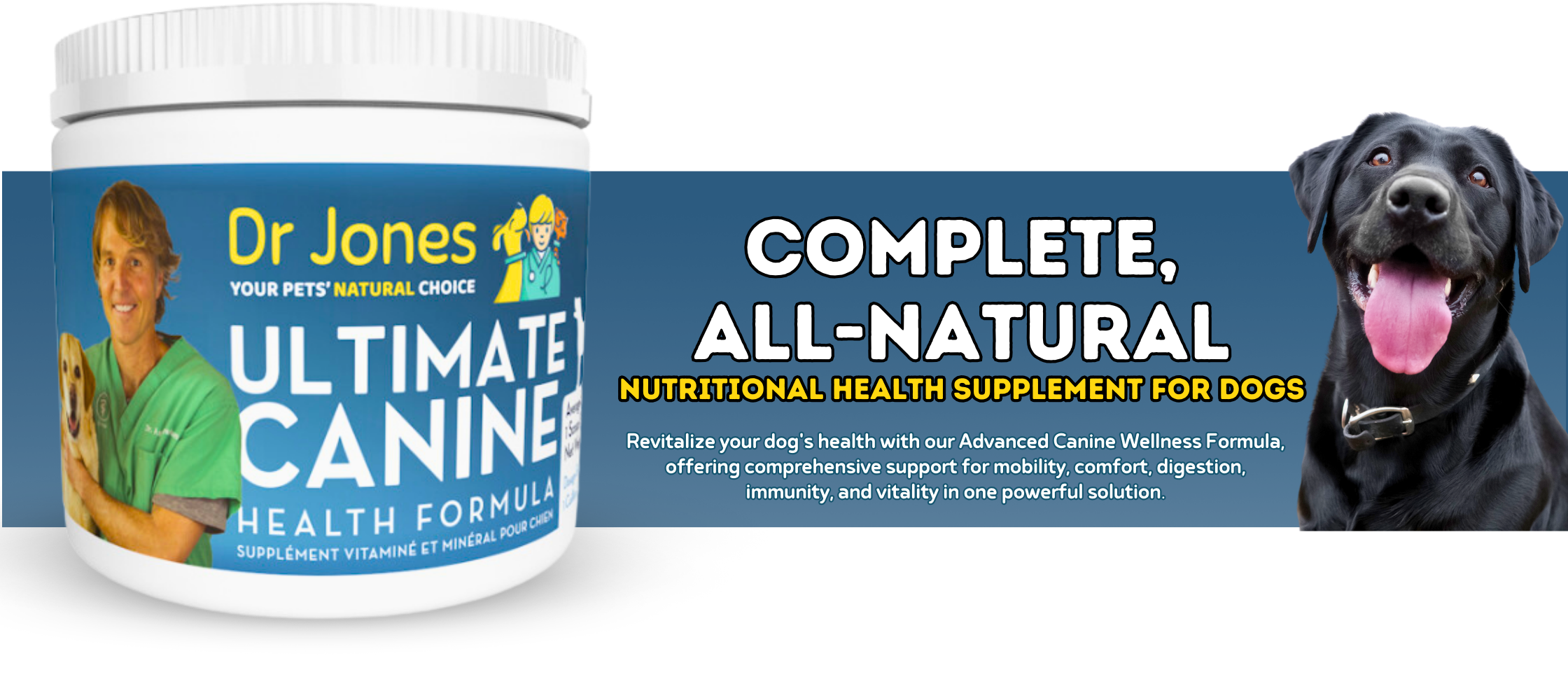8 mistakes your vet is making in surgical anesthesia

Yes even veterinarians make mistakes, and I definitely made some of these myself.
But you as an involved pet parent should be aware of this, and ASK questions IF your dog or cat is to have anesthesia.
Another BIG key in my opinion is to ensure your pet’s organs are functionally optimally, decreasing the likelihood of complications, and helping them recover faster.
There are an array of beneficial nutrients (i.e. antioxidants, probiotics, essential fatty acids) in our supplements for dogs and cats that may do that.
An easy way to help your pets:
For dogs: www.thedogsupplement.com
Boost Your Dog’s Wellbeing with Dr. Jones’ Ultimate Canine Health Formula
Dr. Jones’ Ultimate Canine Health Formula is your go-to solution for keeping your dog healthy, active, and vibrant. This natural, comprehensive supplement promotes everything from joint mobility to digestive health, all in an easy-to-mix powder. Choose what’s best for your dog, whether it’s the Original, Advanced, or Advanced Plus formula!

For cats: www.thecatsupplement.com
Support Your Cat’s Vitality with a Complete Nutritional Formula!
Dr. Jones’ Ultimate Feline Health Formula delivers comprehensive support for your cat’s digestion, mobility, and overall health. With natural ingredients, it promotes lifelong wellness. Set up auto-ship for effortless refills, so your cat never misses a dose!


8 Mistakes Your Vet Could Be Making in Surgical Anesthesia
As veterinarians, our practices must continually evolve, especially when it comes to surgical anesthesia. However, not all vets are current with the latest practices. Techniques have significantly changed over the past decade, and what worked before might now be outdated. I want to share some common anesthesia mistakes that veterinarians could be making, and why it’s essential for you, as a pet owner, to be informed and ask the right questions. Here are eight mistakes you should be aware of when your dog or cat is heading into surgery.
Mistake 1: Assuming Young Patients Are Low-Risk
While older pets tend to have a higher anesthesia risk, assuming young, healthy animals are risk-free is dangerous. The presence of underlying conditions (comorbidities) should always be considered. A thorough preoperative workup, including a physical exam and essential blood tests, is critical for all patients, regardless of age. Always ensure your veterinarian monitors your pet closely during and after anesthesia, as most anesthesia-related deaths occur during recovery.
Mistake 2: Neglecting Equipment Maintenance
Anesthesia machines are complex, and equipment like vaporizers need recalibration every three to five years. Daily checks for leaks and keeping breathing systems clean are essential. Faulty equipment can lead to improper anesthetic dosages, which is dangerous for your pet. A good practice is to have a preoperative checklist that ensures all equipment is functioning properly.
Mistake 3: Failing to Change CO2 Absorbents Regularly
CO2 absorbents need regular replacement. If the granules become hard, they are expended and need to be changed. Relying solely on the color change to determine when absorbents need replacement is risky. Keep track of when you last changed them, using a reminder system like a phone alert or checklist.
Mistake 4: Poor Record Keeping During Anesthesia
Anesthesia records are legal documents and can protect both the veterinarian and your pet. Every drug administered and every event during anesthesia should be meticulously recorded. These records should include specific doses in milligrams or micrograms, not just in milliliters. A dedicated technician can help ensure records are properly maintained.

Mistake 5: Skipping the Anesthesia Checklist
Checklists are lifesavers. They are commonly used in aviation and have been adopted in veterinary practices for a good reason—they help prevent missed steps. From preoperative drugs to monitoring leads, an anesthesia checklist ensures nothing is overlooked. Encourage your vet to use one during your pet’s surgery.
Mistake 6: Underestimating Hypothermia (Low Body Temperature)
Hypothermia is the most common complication during and after anesthesia. Anesthesia interferes with the body’s ability to regulate temperature, and hypothermia can prolong recovery, increase stress, and lower immune response. For instance, if your dog develops a skin infection after surgery, it could be related to hypothermia. Vets should use a multimodal approach to prevent this, such as warming fluids, using heated tables, and applying special blankets designed to retain body heat.
Mistake 7: Allowing the Operating Room to Become a High-Traffic Area
The operating room should be a clean and controlled environment. Allowing unnecessary traffic or using the OR for storage increases the risk of infection. An infection rate higher than 4% for routine, healthy surgeries is concerning. The best practices include keeping the door closed, reducing the number of people in the room, and ensuring the air quality is maintained.
Mistake 8: Scrubbing Techniques That Increase Infection Risk
Believe it or not, traditional scrubbing techniques can do more harm than good. Over-scrubbing with harsh brushes can create micro-abrasions on the hands that harbor bacteria, increasing the risk of surgical infections. The World Health Organization now recommends using alcohol-based surgical hand disinfectants instead of scrubbing with soap and water.
Ask Your Vet Questions!
I know it might feel intimidating, but it’s important to ask your veterinarian about their surgical anesthesia protocols, especially how they plan to prevent hypothermia and manage anesthesia. Don’t be afraid to bring up these suggestions—it’s your pet’s health at stake.
Feel free to share this information with others and ensure your vet is up to date on the best practices for surgical anesthesia.
